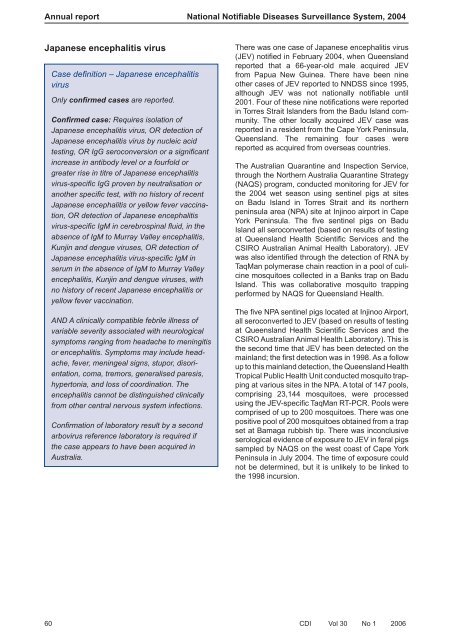PDF file - Department of Health and Ageing
PDF file - Department of Health and Ageing
PDF file - Department of Health and Ageing
You also want an ePaper? Increase the reach of your titles
YUMPU automatically turns print PDFs into web optimized ePapers that Google loves.
Annual report National Notifiable Diseases Surveillance System, 2004<br />
Japanese encephalitis virus<br />
Case defi nition – Japanese encephalitis<br />
virus<br />
Only confirmed cases are reported.<br />
Confirmed case: Requires isolation <strong>of</strong><br />
Japanese encephalitis virus, OR detection <strong>of</strong><br />
Japanese encephalitis virus by nucleic acid<br />
testing, OR IgG seroconversion or a signifi cant<br />
increase in antibody level or a fourfold or<br />
greater rise in titre <strong>of</strong> Japanese encephalitis<br />
virus-specifi c IgG proven by neutralisation or<br />
another specifi c test, with no history <strong>of</strong> recent<br />
Japanese encephalitis or yellow fever vaccination,<br />
OR detection <strong>of</strong> Japanese encephalitis<br />
virus-specifi c IgM in cerebrospinal fl uid, in the<br />
absence <strong>of</strong> IgM to Murray Valley encephalitis,<br />
Kunjin <strong>and</strong> dengue viruses, OR detection <strong>of</strong><br />
Japanese encephalitis virus-specifi c IgM in<br />
serum in the absence <strong>of</strong> IgM to Murray Valley<br />
encephalitis, Kunjin <strong>and</strong> dengue viruses, with<br />
no history <strong>of</strong> recent Japanese encephalitis or<br />
yellow fever vaccination.<br />
AND A clinically compatible febrile illness <strong>of</strong><br />
variable severity associated with neurological<br />
symptoms ranging from headache to meningitis<br />
or encephalitis. Symptoms may include headache,<br />
fever, meningeal signs, stupor, disorientation,<br />
coma, tremors, generalised paresis,<br />
hypertonia, <strong>and</strong> loss <strong>of</strong> coordination. The<br />
encephalitis cannot be distinguished clinically<br />
from other central nervous system infections.<br />
Confi rmation <strong>of</strong> laboratory result by a second<br />
arbovirus reference laboratory is required if<br />
the case appears to have been acquired in<br />
Australia.<br />
There was one case <strong>of</strong> Japanese encephalitis virus<br />
(JEV) notifi ed in February 2004, when Queensl<strong>and</strong><br />
reported that a 66-year-old male acquired JEV<br />
from Papua New Guinea. There have been nine<br />
other cases <strong>of</strong> JEV reported to NNDSS since 1995,<br />
although JEV was not nationally notifi able until<br />
2001. Four <strong>of</strong> these nine notifi cations were reported<br />
in Torres Strait Isl<strong>and</strong>ers from the Badu Isl<strong>and</strong> community.<br />
The other locally acquired JEV case was<br />
reported in a resident from the Cape York Peninsula,<br />
Queensl<strong>and</strong>. The remaining four cases were<br />
reported as acquired from overseas countries.<br />
The Australian Quarantine <strong>and</strong> Inspection Service,<br />
through the Northern Australia Quarantine Strategy<br />
(NAQS) program, conducted monitoring for JEV for<br />
the 2004 wet season using sentinel pigs at sites<br />
on Badu Isl<strong>and</strong> in Torres Strait <strong>and</strong> its northern<br />
peninsula area (NPA) site at Injinoo airport in Cape<br />
York Peninsula. The fi ve sentinel pigs on Badu<br />
Isl<strong>and</strong> all seroconverted (based on results <strong>of</strong> testing<br />
at Queensl<strong>and</strong> <strong>Health</strong> Scientifi c Services <strong>and</strong> the<br />
CSIRO Australian Animal <strong>Health</strong> Laboratory). JEV<br />
was also identifi ed through the detection <strong>of</strong> RNA by<br />
TaqMan polymerase chain reaction in a pool <strong>of</strong> culicine<br />
mosquitoes collected in a Banks trap on Badu<br />
Isl<strong>and</strong>. This was collaborative mosquito trapping<br />
performed by NAQS for Queensl<strong>and</strong> <strong>Health</strong>.<br />
The fi ve NPA sentinel pigs located at Injinoo Airport,<br />
all seroconverted to JEV (based on results <strong>of</strong> testing<br />
at Queensl<strong>and</strong> <strong>Health</strong> Scientifi c Services <strong>and</strong> the<br />
CSIRO Australian Animal <strong>Health</strong> Laboratory). This is<br />
the second time that JEV has been detected on the<br />
mainl<strong>and</strong>; the fi rst detection was in 1998. As a follow<br />
up to this mainl<strong>and</strong> detection, the Queensl<strong>and</strong> <strong>Health</strong><br />
Tropical Public <strong>Health</strong> Unit conducted mosquito trapping<br />
at various sites in the NPA. A total <strong>of</strong> 147 pools,<br />
comprising 23,144 mosquitoes, were processed<br />
using the JEV-specifi c TaqMan RT-PCR. Pools were<br />
comprised <strong>of</strong> up to 200 mosquitoes. There was one<br />
positive pool <strong>of</strong> 200 mosquitoes obtained from a trap<br />
set at Bamaga rubbish tip. There was inconclusive<br />
serological evidence <strong>of</strong> exposure to JEV in feral pigs<br />
sampled by NAQS on the west coast <strong>of</strong> Cape York<br />
Peninsula in July 2004. The time <strong>of</strong> exposure could<br />
not be determined, but it is unlikely to be linked to<br />
the 1998 incursion.<br />
60 CDI Vol 30 No 1 2006
















